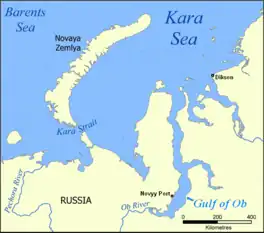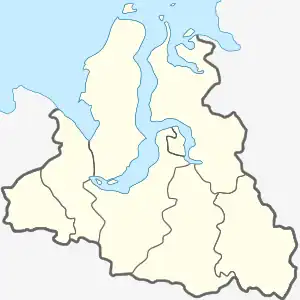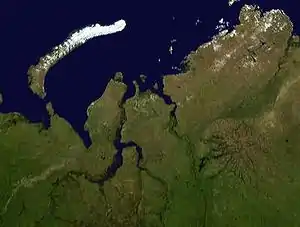Gulf of Ob
The Gulf of Ob (Russian: Обская губа, romanized: Obskaya guba; also known as Bay of Ob, Russian: Обский залив, romanized: Obsky zaliv) is a bay of the Arctic Ocean, located in Northern Russia at the mouth of the Ob River.[2] It is the world's longest estuary.[3]
| Gulf of Ob | |
|---|---|
 Map showing the location of the Gulf of Ob. | |
 Gulf of Ob | |
| Location | Far North |
| Coordinates | 68°50′N 73°30′E |
| Native name | О́бская губа́ (Russian) |
| River sources | Ob River |
| Ocean/sea sources | Kara Sea |
| Basin countries | Russia |
| Average depth | 10–12 m (33–39 ft) |
| Official name | Islands in Ob Estuary, Kara Sea |
| Designated | 13 September 1994 |
| Reference no. | 676[1] |

Geography
The mouth of the Gulf of Ob is in the Kara Sea between the Gyda and Yamal peninsulas.[2] It is about 1,000 km (620 mi) long and varies in width from about 50 to 80 km (31 to 50 mi). It generally runs north and south.[2] The gulf is relatively shallow, with an average depth from 10 to 12 metres (33 to 39 ft), which restricts heavy sea transport. The Taz Estuary is an eastern side-branch formed by the Taz River.
There are several islands near the mouth of the Ob, at the beginning of the estuary, such as Khaley Island. All these islands are close to the shore and they are generally flat and low-lying. They are protected wetlands under Ramsar.[1] Further north, except for a few islands located close to the shore, such as Khalevigo and Nyavigo, the Gulf of Ob is free of islands until it meets the Kara Sea.
Fossil Fuels
Very large natural gas and petroleum deposits have been discovered in this region. To the west is the Yamal project to develop resources in the Yamal Peninsula. To the south-east the Yamburg gas field is the world's third largest natural gas field, located between the southern portion of the gulf and the Taz Estuary to the east. Oil and gas from the wells are sent south via pipeline and rail transport.
A new port has been developed at Sabetta, on the west bank of the gulf, to support the Yamal LNG plant.[5] Commercial operation started in December 2017 with the loading of the first LNG carrier.[6]
Gazprom's Arctic Gate offshore oil loading terminal is in the gulf, designed to operate where ice could be over two meters thick.[7][8]
See also
References
- "Islands in Ob Estuary, Kara Sea". Ramsar Sites Information Service. Retrieved 25 April 2018.
- "Gulf of Ob." Archived 2012-03-20 at the Wayback Machine Earthsnapshot.com. Accessed June 2011.
- "Longest estuary".
- Solovyev A. B..Platonov G. N.. Glazov M. D.. hpak V. O.. V. V. Rozhnov V. V.. 2012. "Distribution of beluga whales (Delphinapterus leucas) in the Russian Arctic seas according to the results of expedition aboard RV Mikhail Somov, September–November 2010. December 2012, Biology Bulletin, Volume 39, Issue 7, pp.654–658, doi:10.1134/S1062359012070102, SpringerLink
- "Port of Sabetta". Ship Technology. Retrieved 12 January 2015.
- Foy, Henry (2017-12-08). "Russia ships first gas from $27bn Arctic project". Financial Times. Retrieved 2018-06-10.
- "Yamal". Gazprom. Retrieved 8 November 2021.
- Staalesen, Atle (16 December 2020). "Ships flock in icy Ob Bay as new grand seaport rises". The Barents Observer. Retrieved 8 November 2021.